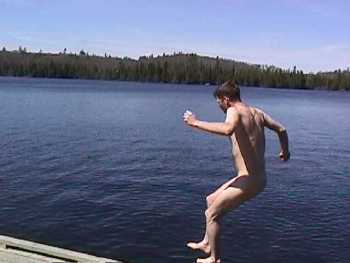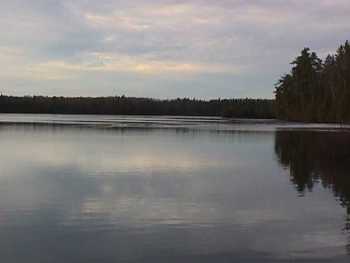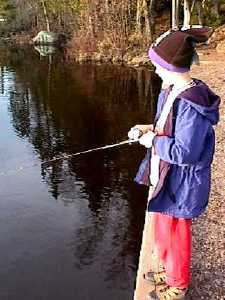4/29/99 –

OB opens the ’99 Sawbill Beach Club in the traditional style, one day after the ice leaves Sawbill Lake. Estimated water temperature: 32.001 degrees.
We’ve had several inquiries about the return of the loons. We have heard several loons calling as they fly over, but have yet to see the return of the pair that nests on south Sawbill Lake. They may have been surprised by the rapid meltdown too. Last night, I heard the woodcocks doing their mating flight and the wood frogs started to croak in the black spruce bog. – Bill

4/27/99 – 7 P. M. It’s official. The ice is substantially clear on Sawbill Lake. Only a narrow band of ice along the east shore remains, but the experts say when the lake is 90% clear of ice, you can declare it out.


Carl Hansen with his fishing pole, but before you call the game warden, be assured that he is just sailing his "Paddle To The Sea" which he recently carved during a course at the North House Folk School
4/27/99 – The ice on Sawbill is not out, but there is no measurement, because my measuring hole is gone. By 8 o’clock last night, Sawbill was about 30 percent out. Carl, Clare and I went for a sunset paddle. The main snowshoe and ski trail heading north up the middle of the lake proved to be more durable than the ice around it. For almost half a mile, the white track, about four feet wide, floated by itself with black, ice cold water on both sides. Ski tracks were plainly visible on it, giving me the irrational urge to put on the skis and try it. Halfway up it, we cut across it with the canoe and it broke at that point. The inertia from our collision carried the end away and a quarter mile of pure white ski trail floated off down the lake.
I expect Sawbill to be officially out by the end of today and will try to find the time to post it here as soon as it happens. – Bill
4/25/99 – A beautiful Sunday afternoon finds the Hansen family jogging, playing catch, washing windows, installing screens, and sunbathing (Cindy) – ahhhh Spring. The summer-like temperatures have taken the lake ice down to 9" in less than two days. At this rate it could be out on Tuesday or Wednesday.
Owl researcher, Bill Lane, sent us the following excerpt from his recent journal. Bill has been in the area for the last six weeks gathering census data and observing the behavior of the Boreal Owl. This is his thirteenth year of research on the diminutive owls. – Bill
April has thus far been unkind to my receptive ears. One low-pressure
system after another has swept across northeast Minnesota, and the winds
have put a damper on completing, even starting my surveys. Bad weather
means that I have no release for my compulsive/obsessive owl disorder;
that I have no excuse to not wash my polypropylene and cook proper
meals. I get six, maybe seven hours of sleep. Life could be viewed as
good. But, I am a biologist and when the weather sours-I get antsy.
In a good year, when nest sites have been located, the weather doesn’t
matter. Something is always happening at the nest, be-it the female
leaving to defecate and cast a pellet, or the male making a food
delivery. Okay, I confess: it’s not exactly like watching a parade-more
like a bobber in a hole in the ice. Nest-site observations do however,
help to answer the myriad of questions about the boreal owl that gnaw at
me every field season.
Of course, in order to locate nests that I can watch in bad weather, I
first have to locate males. My search for boreal owls is facilitated by
the male’s unique song (generally 10 notes per bout; 10 to 12 bouts per
minute) and its extreme audibility (I have heard males from a distance
of over 2 miles). When the male’s song changes though, something is up.
Most notably, the frequency of his singing bouts increase and you sense
that there is a bit of excitement, a little more urgency in his song.
If the short bouts are replaced by a continuous series of notes
(prolonged staccato), our bachelor owl may have found a potential mate.
It’s kind of like a singles bar.
In reality though, the prolonged staccato song provides me with only a
brief glimpse at the courtship of the boreal owl. The question remains:
what is the entire process like? Recently, during yet another weather
interruption, I had the opportunity to put a month’s worth of
observations on one male to use. I had located him on 11 March, and
over the next few weeks, he proved to be a consistent singer, but for
the most part unexcited. Sunday night (4 April) I made a
slumped-shouldered drive up the Sawbill Trail to see if anybody would be
singing in the fog, rain, and tree-creaking winds. At his spot, I
stopped and heard him immediately. I decided to record his singing
activity, feeling it was a better option than talk radio. For the next
hour he sang, averaging 15 bouts per minute. This guy was excited.
When I heard the female, I knew why.
As soon as she vocalized, the male went into a bout of prolonged
staccato, and I went into the woods like a bull through the streets of
Pamplona. When I finally arrived at the cavity tree, the male sat in
the cavity entrance and was in a singing frenzy. I timed his bouts, and
they peaked at 20 per minute, but only for a short time. When the
female vocalized again, he initiated another bout of prolonged staccato,
lasting for 2 min and 9 seconds-without interruption! With nothing to
do, I made myself comfortable and sat beneath the tree letting events
take their course.
I stayed at the site for 4 hours. In that time, the female entered the
cavity three more times. Going through my mental-rolodex of owl
behaviors, I tried to determine where this pair was in the courtship
process. Obviously, judging by the males singing when I arrived on the
site, she was already on his territory. I sensed an opportunity to
expand my understanding of the species. It doesn’t happen often, but I
found myself hoping for bad weather.
My hopes were exceeded the next day, when heavy snow warnings were
issued and flags on the Shore were stiff, like the flag on the moon.
The weather cooperated, the female didn’t. I arrived at the cavity site
at 1830 (owls don’t adjust for Daylight Savings Time), and sure enough,
8 minutes later I heard the male singing during his journey to the
cavity. At this point, I told myself “the female will be here in no
time.” I didn’t even zip up my coat. The male sang at 14 or 15 bouts
per minute. Snow started falling. He bounced from the cavity to a
pine, then a spruce branch not more than 10 feet above me. One hour
passed. The winds picked up and he just kept singing. At 2230, I
recorded three observation in my field book: 1) male still singing; 2)
female a no-show; and 3) getting hypothermic. I arrived at the site
during the springtime and left in a blizzard.
Weather conditions improved enough for surveys on Tuesday, but I did
manage to visit the site again, convinced that the female was an
integral part of the cavity tree’s avi-fauna. At 0200, I got out of my
truck and was met by silence. That in itself told me that things were
getting serious. After 20 minutes the male started singing, first in a
subdued staccato, but when the female vocalized, he did his thing. He
let out a prolonged staccato song lasting for 1 minute 54 seconds,
interspersed with a two second pause, then 2 min and 11 seconds of
prolonged staccato. I believe I now know why birds have air sacs.
The next night (8 April), I arrived at the site at 1830. Sure enough at
1836, the male flew right into the cavity and started singing away. At
one point, he dropped to the bottom of the cavity and continued
singing-probably admiring his song. At 1905:40, the female vocalized
from a small stand of black spruce approximately 50 meters to the west.
The male, as you can probably predict by now, went into another bout of
prolonged staccato. At 1910, she again vocalized but stayed in the
black spruce. Then, after my many mental pleadings, she arrived at the
cavity and didn’t even pause. She just flew right in. Interestingly,
she appeared to have something in her foot, which I deduced to be some
nesting material (I often find moss and lichen at the bottom of owl
nests).
The male took off to the east while she sat at the cavity entrance
wondering where her Fabio went. At 2116, with the female tucked deep in
the cavity, the male arrived again, made a brief vocalization, and then
made a delivery to the female. I packed my gear and headed to my
truck. There would be no more frantic singing and no more courtship
behaviors to watch. It was again time to hope for good weather.
4/24/99 – Sawbill Lake ice 15". I saw seven moose on the way home from Ely last night. Northeastern Minnesotans For Wilderness had its annual membership meeting at Camp Du Nord on the north arm of Burntside Lake. It was a beautiful day. Temperatures near 70 degrees, blue skies and black ice on Burntside. A small, but dedicated group of local folks who support wilderness, discussed the issues, heard from the Boundary Waters and Voyageurs National Park managers, shared a meal, and danced to the Wild Thyme band. Becky Rom, an Ely native and daughter of pioneer outfitters Bill and Barb Rom, gave a moving tribute to her childhood mentor, 4/21/99 – Sawbill Lake ice: 16". I saw five moose on the way home from town last night. The moose are shedding their winter coats right now, which turns them nearly white and very scroungy looking. They seem more skittish than usual, almost as if they are embarrassed by their shabby appearance. I guess it is like that bad dream where you are at school and realize that you are only wearing your underwear. If the moose could blush, they probably would. – Bill 4/20/99 – The Minnesota Pollution Control Agency was here yesterday doing research in Sawbill Creek. They are studying Sawbill Creek in connection with a study of the effect of development and logging on watersheds. Sawbill Creek is a control for the experiment. In other words, it is a creek without significant development or logging that they can compare to other creeks to quantify any changes that might occur. It is well known that logging increases the water temperature in adjacent streams, which reduces trout populations. – Bill 4/19/99 – Sawbill Lake ice depth: 17", 6" of slush and 11" of solid ice. 4/16/99 – Sawbill Lake ice depth: 20". 4/15/99 – The ice on Sawbill Lake is 24" thick. The top layer is about 5" of slush ice and is pretty degraded. Then there is a middle layer of 4" of water. Finally, 15" of solid ice. There is plenty of ice for travel, but you would sure get your feet wet. The weather service keeps predicting snowfall, but so far Spring weather prevails. Redwing blackbirds and starlings are the latest migrants to arrive at Sawbill. The kids and I had another startling natural event on the way home from school today. As we passed the steel bridge that crosses the Temperance River six miles north of Tofte, we were astounded by the condition of the river. We made our way onto the bridge and stood in awe. Apparently, the river ice had formed a major dam somewhere upstream. The ice dam had broken and sent a flash flood of water, ice and debris down the river. The rampage was four or five times the usual height of the river. The galloping, coffee colored water was choked shore to shore with huge ice blocks. Amongst the turmoil were dozens of whole trees, ripped from the river banks by the violence. The whole stew was moving along at about ten miles per hour. As we watched in amazement, the ice and debris began to thin, and within ten minutes the river was back to straight water with just the occasional ice flow. We were tempted to race back to Temperance River State Park to watch maelstrom drop over the high falls, but I was frankly scared to get too close to that kind of raw natural power. – Bill 4/14/99 – We have finally worked the bugs out of our new microwave radio-telephone system that was installed nearly a year ago. The system had some minor problems at first, but had deteriorated throughout the winter until it was barely usable. Good detective work by technician Steve Schuh finally solved the problem yesterday and we are enjoying truly clear telephone conversations for the first time in our history. We are not popping the champagne cork until it has worked trouble free for a couple of months, but I feel we are on the right track. Part of the radio-telephone work required me to climb the 180′ tower on top of the Lutsen Mountains Ski Area yesterday. It was 60 degrees and completely calm (a rare occurrence at that altitude). The sky and Lake Superior were a matching deep blue. The view was spectacular for 360 degrees. The ski area was closed, but they were having their annual crew party. It was fun to watch people having a relaxing day of skiing on the very hills where they work so hard the rest of the season. In the quiet, I could clearly hear their conversations as they paused to rest on the slopes. It was an exhilarating, yet strangely calming experience. – Bill 4/11/99 -Today is probably the last day of skiing for the year. Water is starting to pool on the ice around shore, making it difficult to access the ice sheet without getting your ski boots wet. After my chilly plunge last year, I am a little gun shy about spring ice. 4/10/99 – 28" of ice measured on Sawbill Lake today. This is still more than enough for skiing. I skied from the landing to the Ada Creek Portage and back (12 miles) in 52 minutes. 30 minutes up and 22 minutes back. It gives you a clue which way the wind was blowing. With the 20+ mph wind at my back, I felt how the Olympians must feel all the time. As I came flying back down Sawbill, I noticed a critter on the ice ahead. As I drew nearer, it resolved into an otter, loping across the widest part of the lake. My course brought me into a perfect intersection with the graceful animal. I thought it surely must see me, as I was right in the middle of the huge sheet of white ice. When I was about 100 yards away, it suddenly stopped, looked at me, and then doubled its speed toward shore. When it hit top speed, it dropped on its stomach and slid for 5 feet or so. It would run five or six steps and then slide again. By the time it reached a spot of open water near shore, I was only ten feet behind it. It did one last belly flop, coasting well over 15 feet and slipped like greased lightning down the hole. – Bill 4/7/99 – We were greeted by seven inches of new snow yesterday morning. It continued to snow lightly through the noon hour, then a few peeks at the sun and rising temperatures melted about half of the wet snow. Karl Hansen and Lee Stewart, Sawbill’s first seasonal employees, were forced to take a snow day on their second day of work. When they tried to drive up the Sawbill Trail from Tofte, they encountered 14+" of heavy snow in the hills above Lake Superior. Skies are leaden again this morning, making almost a week of rain, snow and fog. It is a good omen for the summer that we are having a wet weather pattern now. Hopefully, we will avoid last year’s nearly disastrous drought. – Bill 4/5/99 – OB is off for a few weeks of vacation, so the newsletter is likely to be less descriptive for awhile. We returned from a week in the Caribbean to be greeted by freezing rain, slush, gray skies, wet snow, and slushy mud – a sure prescription for depression. Actually, the signs of Spring are encouraging, especially the brightly colored birds that are flocking to the feeder. In the midst of the gloom and rain, the birds have been providing a chorus of beautiful song. The BWCA Wilderness Permit Reservation Office was having phone trouble last week. If you tried to call and couldn’t get through, it should be OK now. Remember, it is a new toll free number this year: 1-877-550-6777 or on the Internet at: www.bwcaw.org. – Bill
Questions or comments? Please direct them to:
Sigurd F. Olson, on this 100th anniversary year of his birth. – Bill
